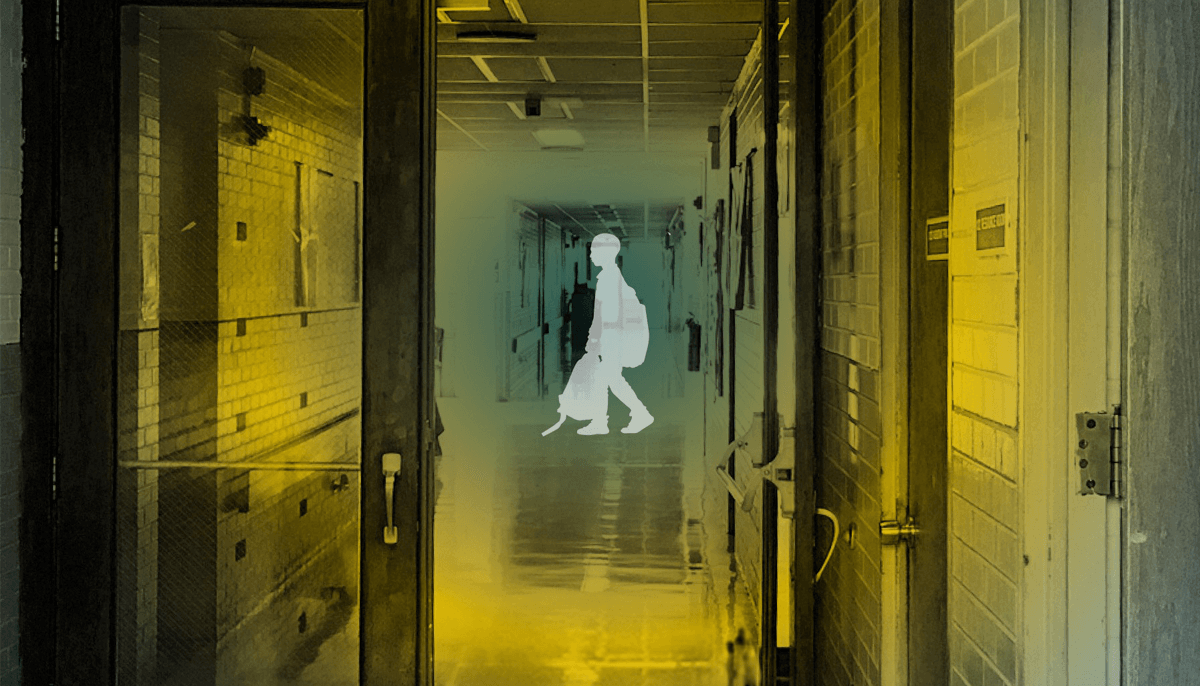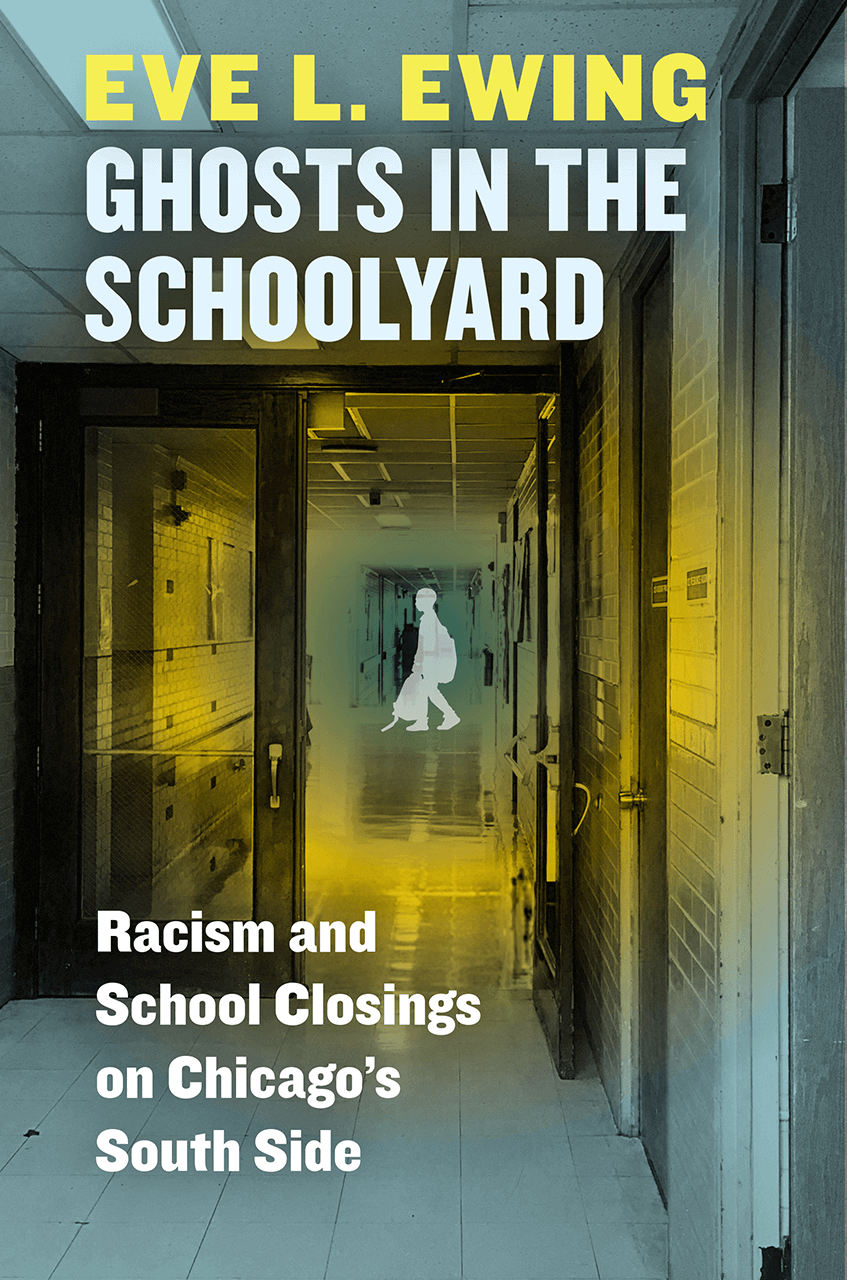
Ghosts in the Schoolyard: Racism and School Closings on Chicago’s South Side
by Eve L. Ewing
University of Chicago Press, 2018, $22.50; 240 pages.
As reviewed by Paul E. Peterson
 Closing schools is as American as the 19th-century homesteading land rush. Indeed, it’s the flip side of desperate sprints for land, silver, or gold. When people race for distant treasure, they leave the rest behind.
Closing schools is as American as the 19th-century homesteading land rush. Indeed, it’s the flip side of desperate sprints for land, silver, or gold. When people race for distant treasure, they leave the rest behind.
From its beginning, the United States has been a low-density, highly mobile country, a nation where young men and women sought opportunity in the West, and a place where former slaves hopped on trains bound for factory jobs available near Chicago’s South Side.
When people move, they abandon their friends, neighbors, and institutions. Stay-at-home farmers—the descendants of the homesteaders—were the first to face the loss. When fewer families were needed to till the soil, thriving communities turned into ghost towns. The bell atop the little red schoolhouse became a museum piece.
Efficiency experts like Stanford’s first School of Education dean Ellwood Cubberley accelerated the change. “The [school] district unit is entirely too small an area to provide modern educational facilities,” he said. The “system is expensive, inefficient, inconsistent, short-sighted, unprogressive and penurious; it leads to a great and unnecessary multiplication of small and inefficient schools.” The efficiency argument proved influential. Some 120,000 school districts in operation in 1940 were consolidated into fewer than 15,000 today. Enrollment at the average school climbed from 85 pupils in 1930 to 300 students in 1960. Whatever efficiencies were realized came at the expense of community institutions. When high schools merged, towns lost their own Friday-night football, high-school band, and senior play.
While towns were dying, big-city neighborhoods were swarming with newcomers. Eve Ewing’s account of life in Bronzeville on the South Side evokes the buzzing action at 45th and South Park in the 1940s. Jazz clubs were abundant: Count Basie and Sarah Vaughan were performing at the Parkway Ballroom. The neighborhoods were giving birth to luminaries like Ida B. Wells and Mahalia Jackson. The beloved Walter Dyett, a classical violinist of African American descent, conducted the DuSable High School band.
All that action contained a healthy bundle of graft, corruption, and machine-style politics. Then, in 1947, Chicago’s schools were “reformed.” In the following decades, even Mayor Richard J. Daley, himself a homegrown machine-politics guy, allowed the school superintendent, Benjamin Willis, full discretion over personnel and procurement. Many years ago I wrote in School Politics, Chicago Style that schools and politics in Chicago had become sharply separated. The procedures of the school board reinforced
its isolation from external political forces. The public could attend board meetings, but virtually no provision for audience participation existed. . . . Hearings were held after the “tentative” budget had already been prepared by staff members. . . . The very layout of the boardroom accentuated the separation of the board from the outside world. Board members sat in a semi-circle with their backs to the audience.
Still, Willis, by taking much of the boodle out of building, was able to erect vast numbers of new elementary schools to accommodate both baby boomers and African American migrants. By 1970, 596,375 students attended a Chicago public school.
The efficiency principle was applied to housing policy as well, Ewing tells us. At the height of the New Deal, the federal government encouraged cities to raze “slums” and build high-rise public housing with modern kitchens and bathrooms. The Chicago Housing Authority, with the best of intentions, constructed a massive but deeply flawed low-income public housing complex along a substantial swath of the South Side’s waterfront. By 1970, half the residents of Bronzeville were living in these units.
Unfortunately, the buildings were too tall, the elevators too few, the units too one-dimensional (accommodating large families only), and the complex too segregated. Crime, gangs, property destruction, mismanagement, and chaos were all but inevitable.
 In 1999, the housing authority demolished the high-rises, and local schools lost thousands of students. Fourteen years later the school administration announced that several of Bronzeville’s schools would be included in a citywide plan to close about 50 schools on the grounds that the number of students “is below the enrollment efficiency range, and thus the school is underutilized.”
In 1999, the housing authority demolished the high-rises, and local schools lost thousands of students. Fourteen years later the school administration announced that several of Bronzeville’s schools would be included in a citywide plan to close about 50 schools on the grounds that the number of students “is below the enrollment efficiency range, and thus the school is underutilized.”
It was not just Bronzeville that was losing students. By 2018 enrollment in district-operated schools in Chicago numbered little more than 300,000. Half of Chicago’s children were gone—57,000 to charter schools and many more to suburbs, private schools, and places unknown. Meanwhile, revenues were not keeping pace with expenditures, and school-district debt was rising.
Ewing barely acknowledges these basic facts in her book. Instead, her case studies rely upon her experiences as a Bronzeville teacher, transcripts of public hearings on the closings, and interviews with no more than 13 teachers and students, all of which arm her with the conclusion that “it is impossible to get around the fact that the school closure process . . . was racist.” Employing what is identified as “critical discourse analysis,” the author takes at face value the charges of racism made by community activists at closure hearings.
At the same time, she refuses to believe Chicago’s superintendent of schools, a black woman, when she denies that charge vehemently at a public hearing Ewing attended: “What I cannot understand, and will not accept, is that the proposals I am offering are racist. That is an affront to me as a woman of color. . . . Underutilized schools in these areas are the result of demographic changes and not race.”
Walter H. Dyett High School, named for Bronzeville’s illustrious band teacher, is the book’s centerpiece. By 2011, its enrollment had slipped to two-thirds its 2004 level. The administration decided to close Dyett on the grounds that its “graduation rate . . . is far below that of other schools in its area and [it] is among the lowest academic scoring schools in the district.” All existing students could remain at the school for the next four years, but no new students would be admitted.
Whether or not Chicago’s administrators were racist, they were surely inept. They gave inadequate advance notice of the time and place of meetings, placed strict time limits on speakers, did not respond to questions, and precluded anyone from speaking who had not registered before the meeting began. But if their intention was to march blithely toward their goal, they made a serious misstep: by permitting Dyett to stay open for four more years, they handed over to activists the time needed to form the “Coalition to Revitalize Dyett,” mount a prolonged protest, and propose a revitalized neighborhood school devoted to “global leadership and green technology.” A hunger strike captured newspaper headlines.
In the end, the administration buckled under relentless charges of racism. Dyett was given $15 million for new facilities, and in 2016 was re-launched in a new South Side location as the Walter H. Dyett High School for the Arts.
To some, the story might appear to be a brilliant display of black power. But for the activists—and for Ewing—it represents another racist abuse of bureaucratic power. “The members of the Coalition did not see their plan for Dyett come to fruition.” Instead of a neighborhood school focused on leadership and green technology, the new school would be devoted to the arts and open its doors to students from across the city. Ewing says the whole story is a “troubling history of racism.”
That conclusion requires better documentation. Ewing says a disproportionately large number of the schools selected for closing had student bodies that were majority African American. But only 9 percent of Chicago’s enrollment was white in 2009, when the closing movement had yet to begin. The main alternative to an African American student in Chicago is a Hispanic one or a student from another minority group.
Nor are we provided with any information on the background of those who opposed the closings or how well they represented the local community. One has to wonder whether the activists really spoke for the neighborhood when 81 percent of the students in the area were choosing to go to a high school other than Dyett, and African American parents were more likely than others to place their children in charter schools.
Ewing also neglects to tell us how much financial and logistical support the activists received from the Chicago Teachers Union, whose then president was adamantly opposed to charter schools and labeled Mayor Rahm Emanuel (formerly chief of staff to Barack Obama) the “murder mayor.” Would the protests have been as effective had they not had unqualified union support?
The author bases her charge of racism largely on the lack of school administrator interest in the testimony presented by activists at public hearings. But such practices are deeply ingrained in the Chicago board’s insular decisionmaking style. The plan to close schools was less likely to be racist and more likely to be driven by fiscal considerations that Ewing chooses to virtually ignore.
Ewing is at her best when she captures the heartache that attends any school closing. Her mourning for lost institutions will resonate with those from small-town USA, who see ghosts of marching bands and teeter-tottering children on vacant lots where schools once stood. Beneath her critical discourse analysis, one finds a melancholy tale that is quintessentially American.
Paul E. Peterson, a professor at Harvard University, is director of its Program on Education Policy and Governance and senior editor of Education Next.
Another review of this book, by Marilyn Anderson Rhames, can be found here.
This article appeared in the Summer 2019 issue of Education Next. Suggested citation format:
Peterson, P.E., and Rhames, M.A. (2019). Shuttering Schools in Chicago: Scholar links closings to city’s history of discrimination. Education Next, 19(3), 75-78.


